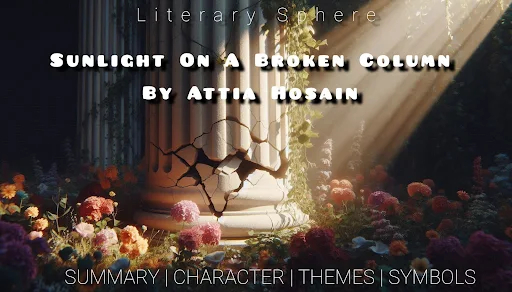The Title Significance of Sunlight on a Broken Column by Attia Hosain
The Title Significance of Sunlight on a Broken Column by Attia Hosain
The title "Sunlight on a Broken Column" by Attia Hosain is rich in symbolism and deeply reflective of the themes and narrative of the novel. It captures the essence of the protagonist’s journey and the socio-political context in which the story unfolds. To fully understand the significance of the title, it is essential to delve into its symbolic meanings and how it relates to the broader themes of the novel.
Symbolism of the Broken Column
A column is traditionally a symbol of support, strength, and stability. It often represents a foundational element of architecture and by extension, society. The concept of a "broken column" thus conveys a sense of fragmentation and disarray. In the context of the novel, the broken column symbolizes the disintegration of traditional values and societal structures in India during a period of immense change. The novel is set against the backdrop of India’s struggle for independence and the subsequent partition, events that shattered the old social order and created a sense of instability and loss.
The "broken column" can be seen as a metaphor for the protagonist Laila’s own life and the lives of those around her. Just as the column has been damaged and is no longer able to provide the support it once did, so too have the traditional structures and values that Laila and her family once relied upon been disrupted. This brokenness reflects the personal and societal upheavals that occur throughout the novel. The column, once a symbol of support and stability, now represents the fractured state of the characters’ lives and the world they inhabit.
Significance of Sunlight
The term "sunlight" in the title introduces a contrasting element of illumination and hope. Sunlight is often associated with clarity, warmth, and a new beginning. In juxtaposition to the broken column, sunlight suggests a glimmer of hope and the potential for renewal and growth despite the destruction and chaos. It implies that even in the midst of upheaval and fragmentation, there is a possibility for understanding, enlightenment, and transformation.
For Laila, sunlight represents her personal aspirations and her quest for a life beyond the constraints of traditional values. It symbolizes her desire for education, independence, and a more modern existence. Despite the societal pressures and familial expectations that confine her, the metaphorical sunlight signifies her inner strength and the hope she holds for a better future. The interplay between the broken column and the sunlight thus encapsulates the duality of destruction and hope that characterizes her journey.
Reflection of Themes
The title reflects several key themes of the novel:
1. Tradition versus Modernity: The broken column represents the clash between traditional values and modern aspirations. Laila’s struggle to reconcile her desire for education and personal freedom with the conservative expectations of her family is emblematic of the broader societal conflict between tradition and modernity. The broken column symbolizes the fracturing of traditional norms, while the sunlight represents the emerging modern ideals that challenge these norms.
2. Personal and Societal Upheaval: The novel deals with significant personal and societal upheaval, particularly in the context of India’s independence and partition. The broken column symbolizes the chaos and destruction that accompany these historical events. It reflects the disruption of established social structures and the impact of these changes on individuals like Laila. The sunlight, in this context, suggests the possibility of recovery and adaptation amidst the turmoil.
3. Identity and Transformation: The broken column and sunlight also symbolize the theme of identity and transformation. Laila’s journey is one of self-discovery and personal growth as she navigates the challenges of her environment and the societal changes around her. The broken column represents the loss of her old identity and the traditional roles imposed upon her, while the sunlight signifies the emergence of a new sense of self and the potential for transformation.
4. Cultural Heritage and Change: The tension between preserving cultural heritage and adapting to change is another theme reflected in the title. The broken column symbolizes the erosion of cultural traditions and the impact of modernization. Sunlight, on the other hand, represents the new opportunities and possibilities that arise from cultural change. The title encapsulates the struggle to maintain cultural heritage while embracing new realities.
Narrative Connection
In the narrative, the broken column is a physical and symbolic representation of the characters’ experiences and the shifting social landscape. The novel’s setting, including the family home and its changing circumstances, mirrors the broken column’s symbolism. As the characters grapple with personal and societal changes, the broken column becomes a metaphor for their struggles and the broader transformations occurring in their world.
Sunlight serves as a recurring motif throughout the novel, symbolizing moments of clarity, hope, and new beginnings. It is through the sunlight that Laila and other characters find the strength to confront their challenges and seek a path forward. The interplay between the broken column and the sunlight reflects the novel’s exploration of the complex dynamics of change, resilience, and the search for meaning amidst uncertainty.
Conclusion
The title "Sunlight on a Broken Column" encapsulates the novel’s exploration of themes related to tradition, change, identity, and resilience. The broken column symbolizes the fragmentation of old values and structures, while the sunlight represents hope, enlightenment, and the potential for renewal. Together, these elements reflect the personal and societal upheavals faced by the characters, particularly Laila, as they navigate the transformative period of India’s history. The title effectively captures the novel’s central concerns and the dynamic interplay between destruction and hope, tradition and modernity, that defines the narrative.

Join the conversation